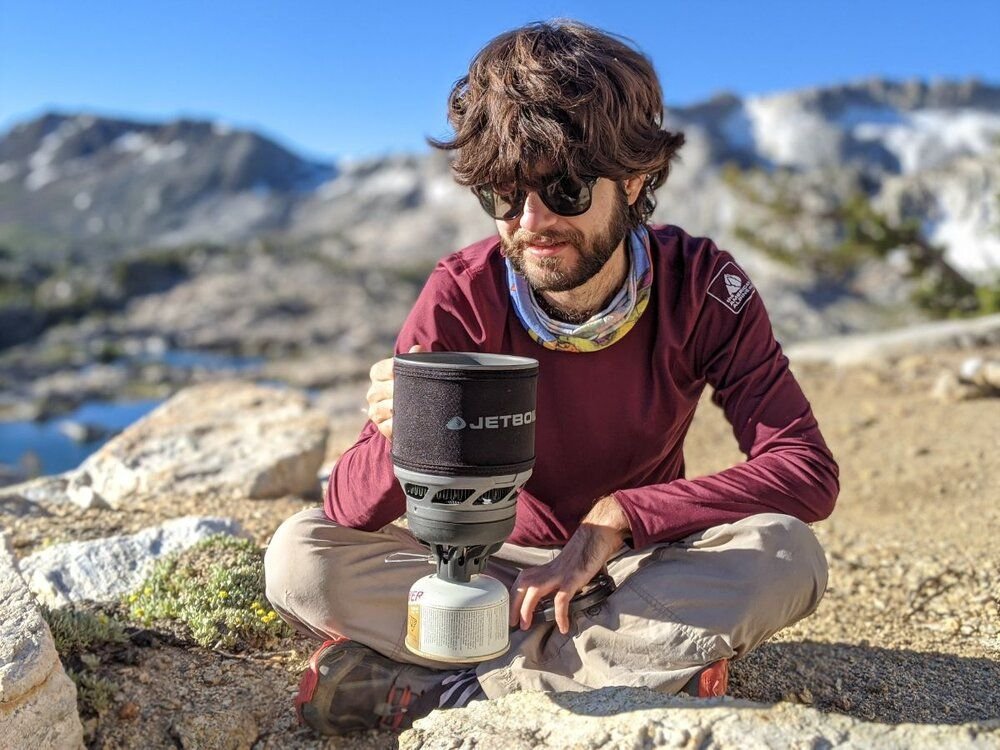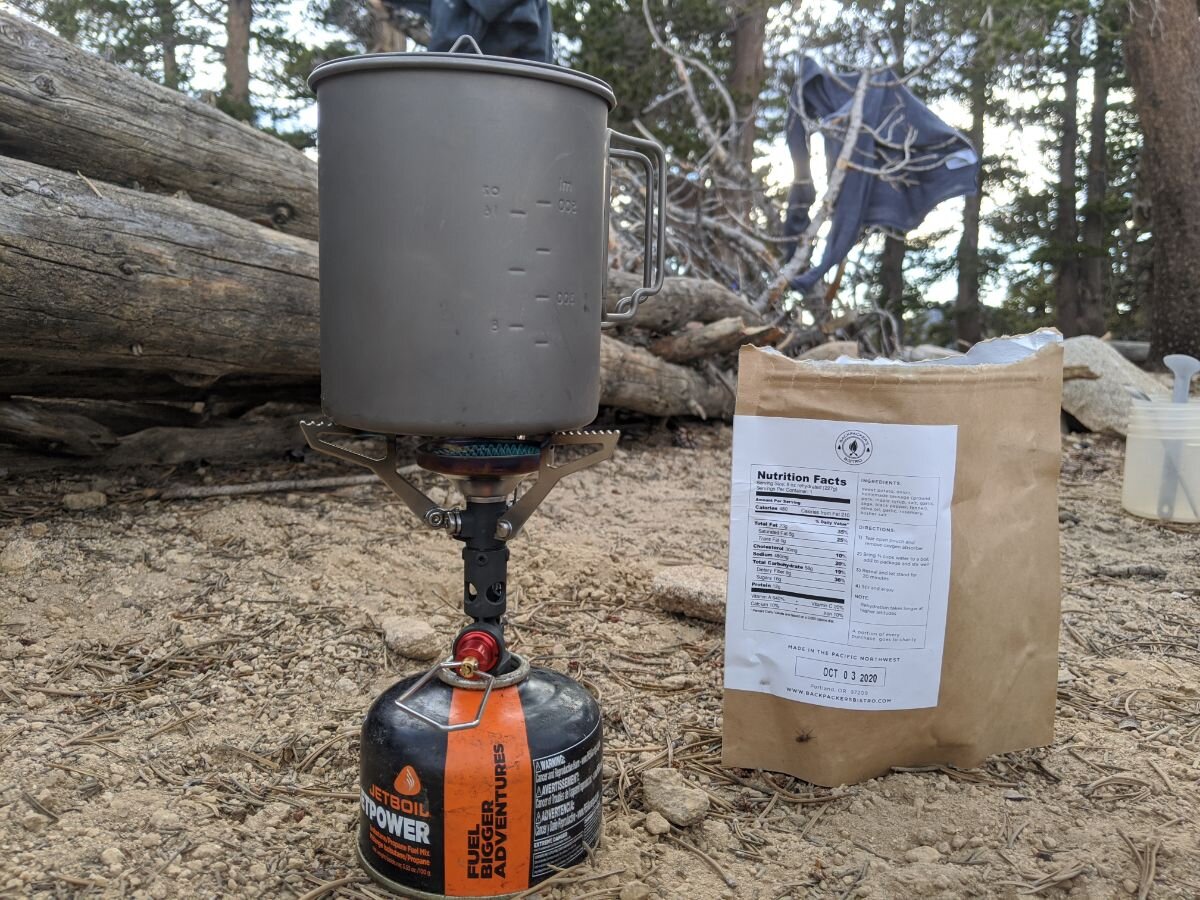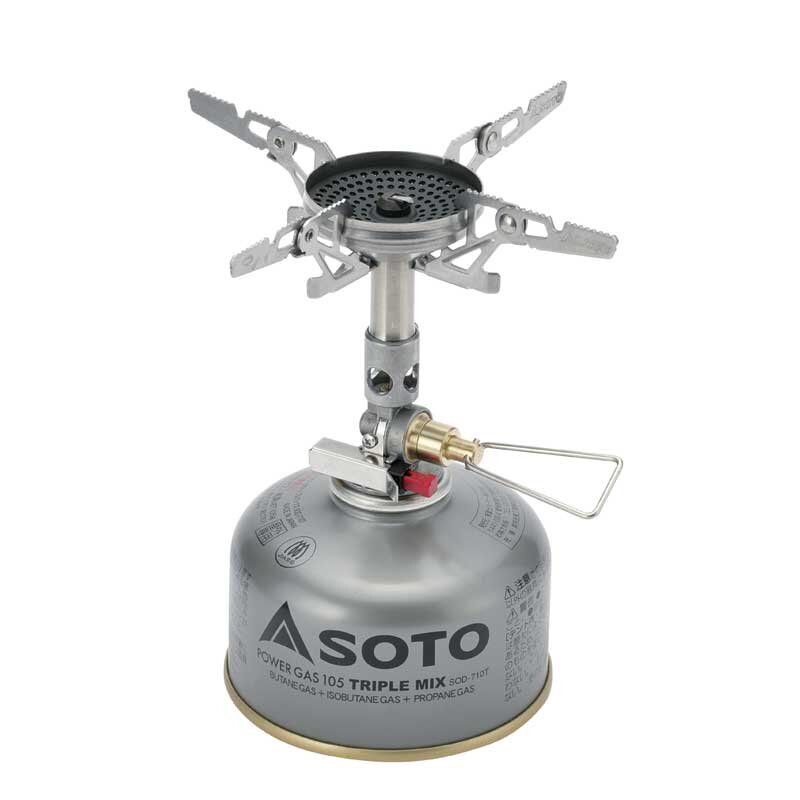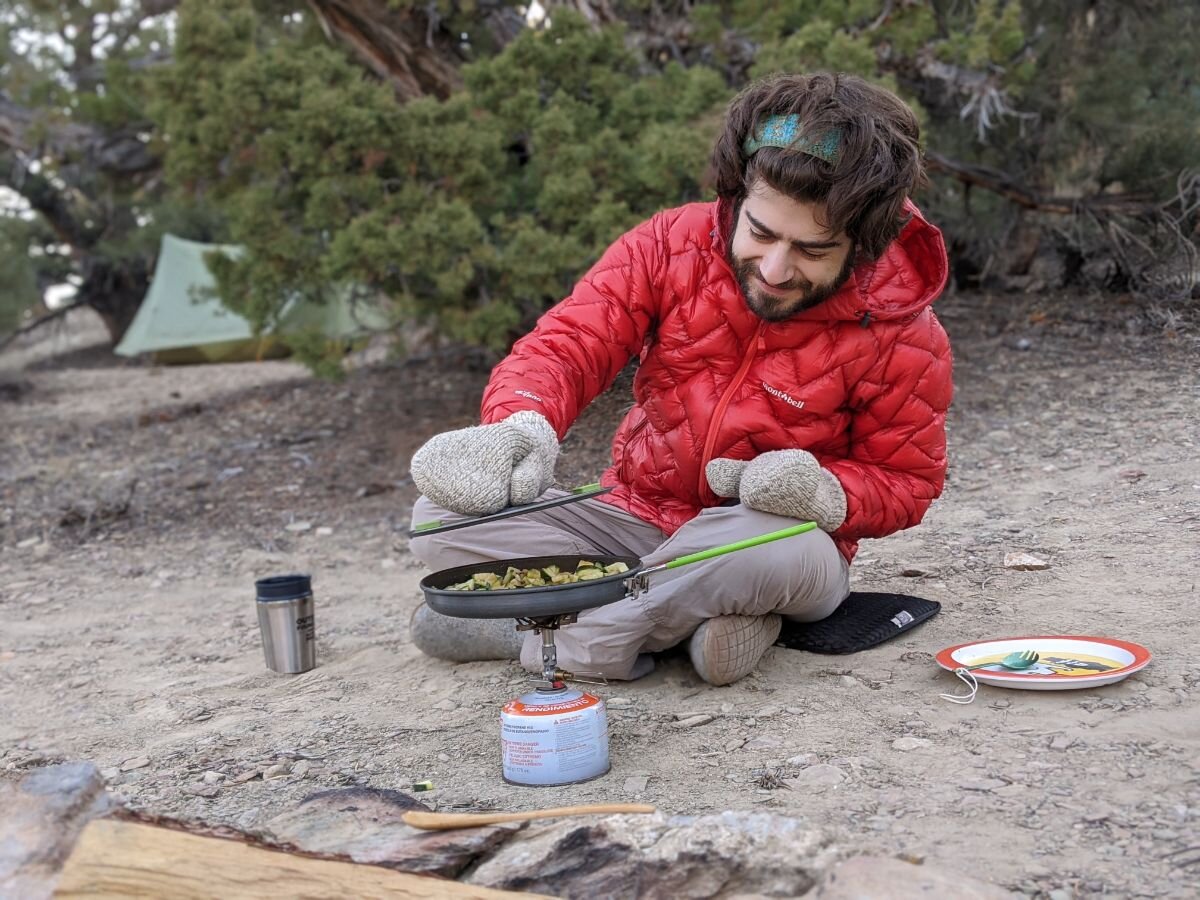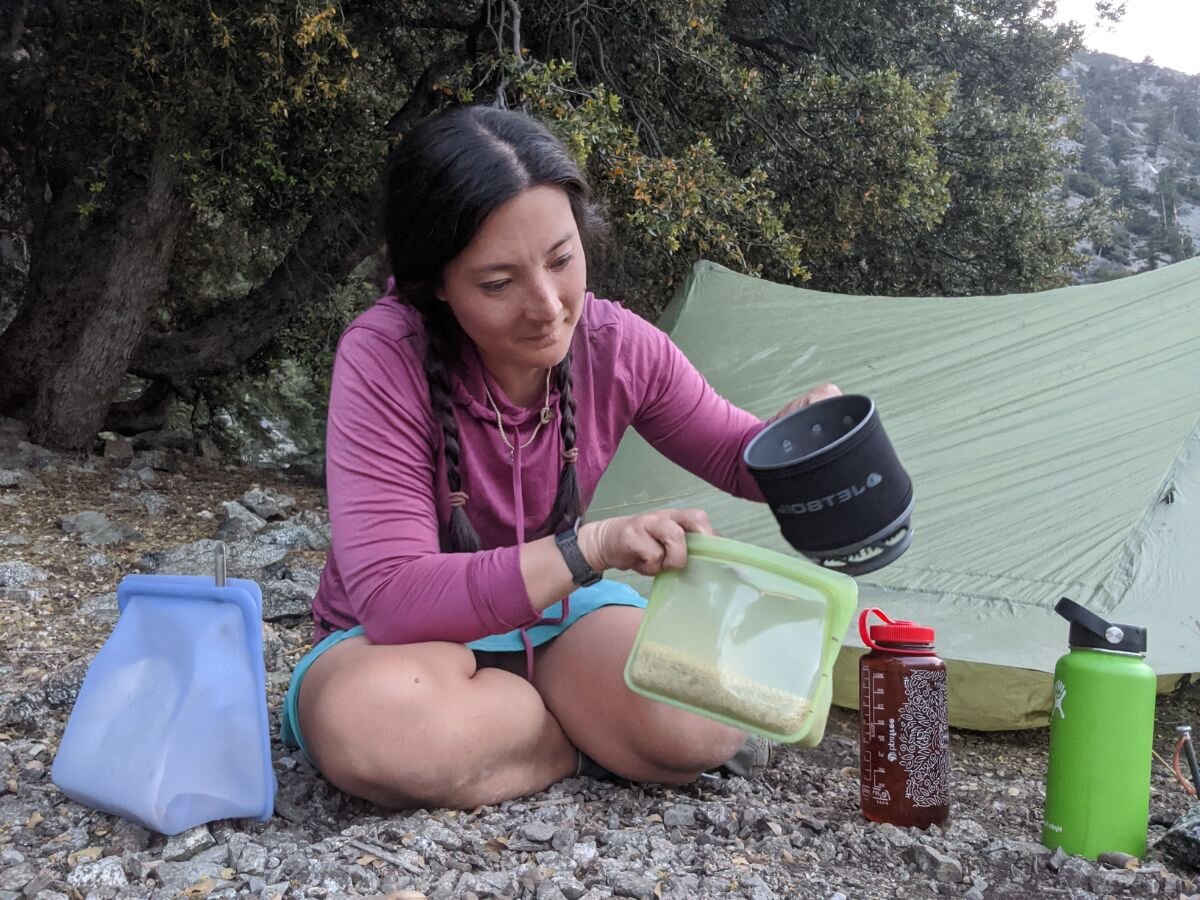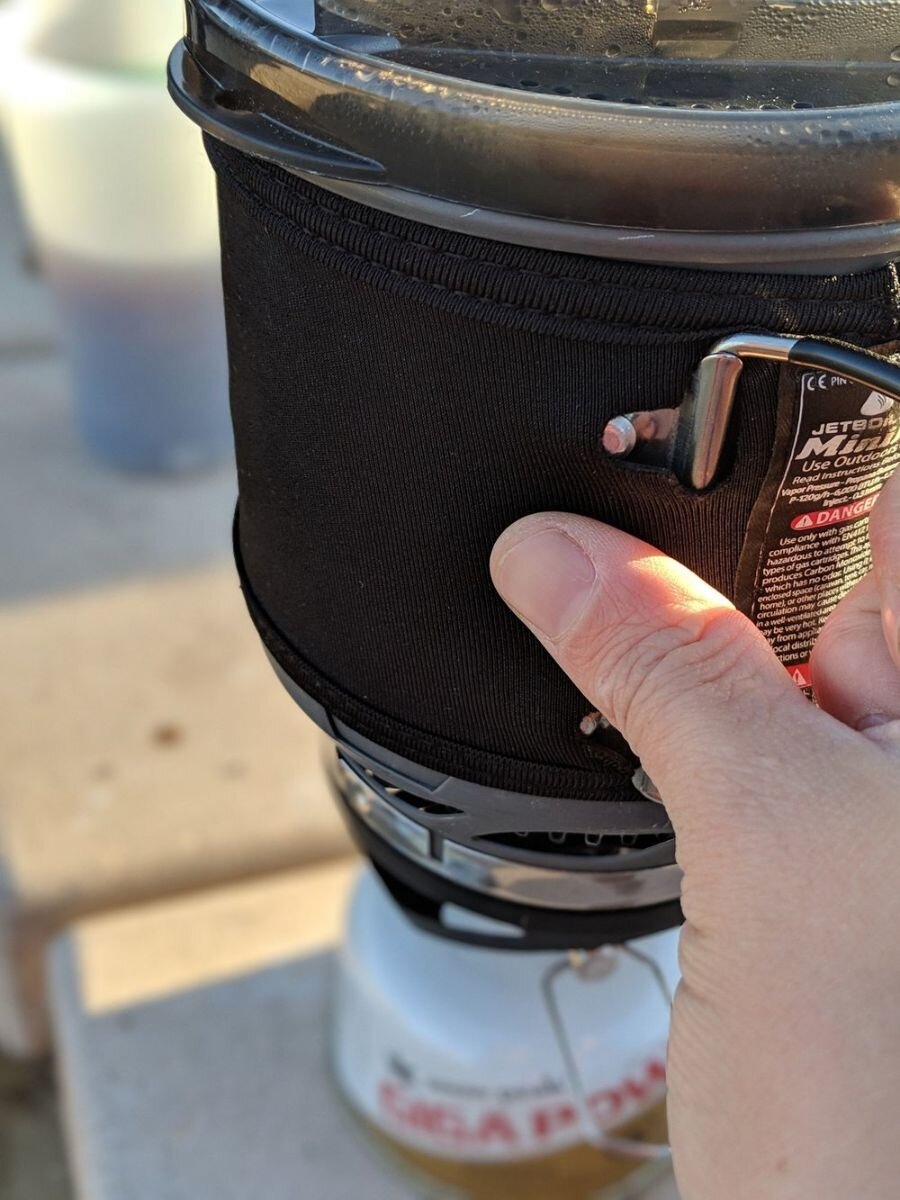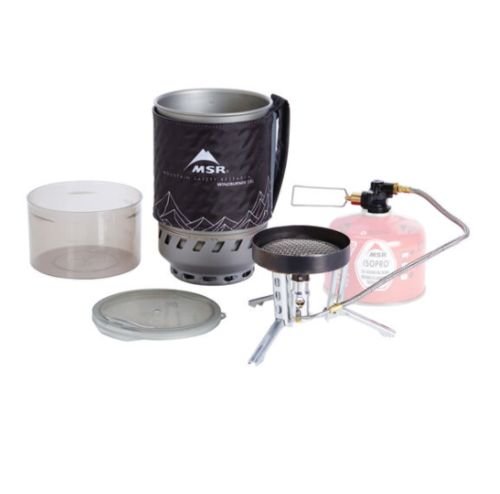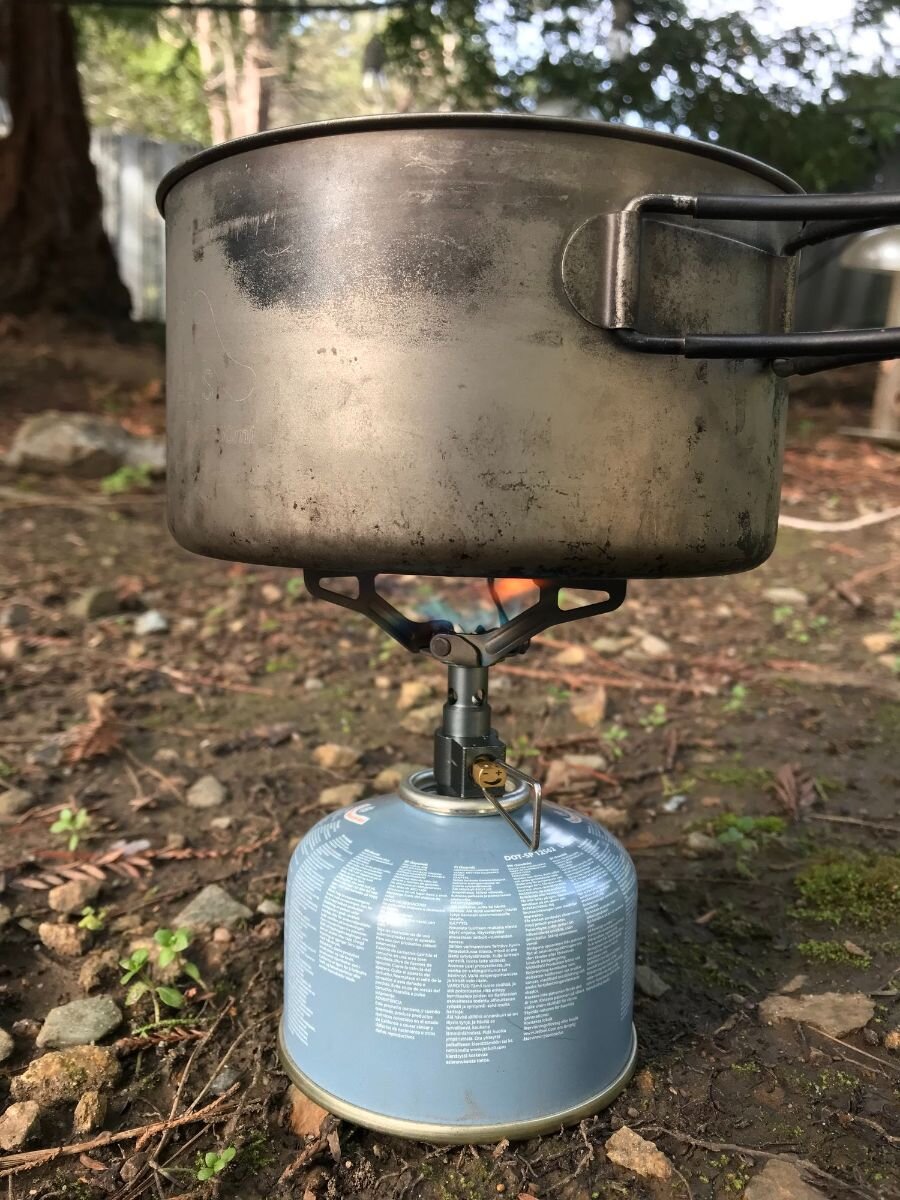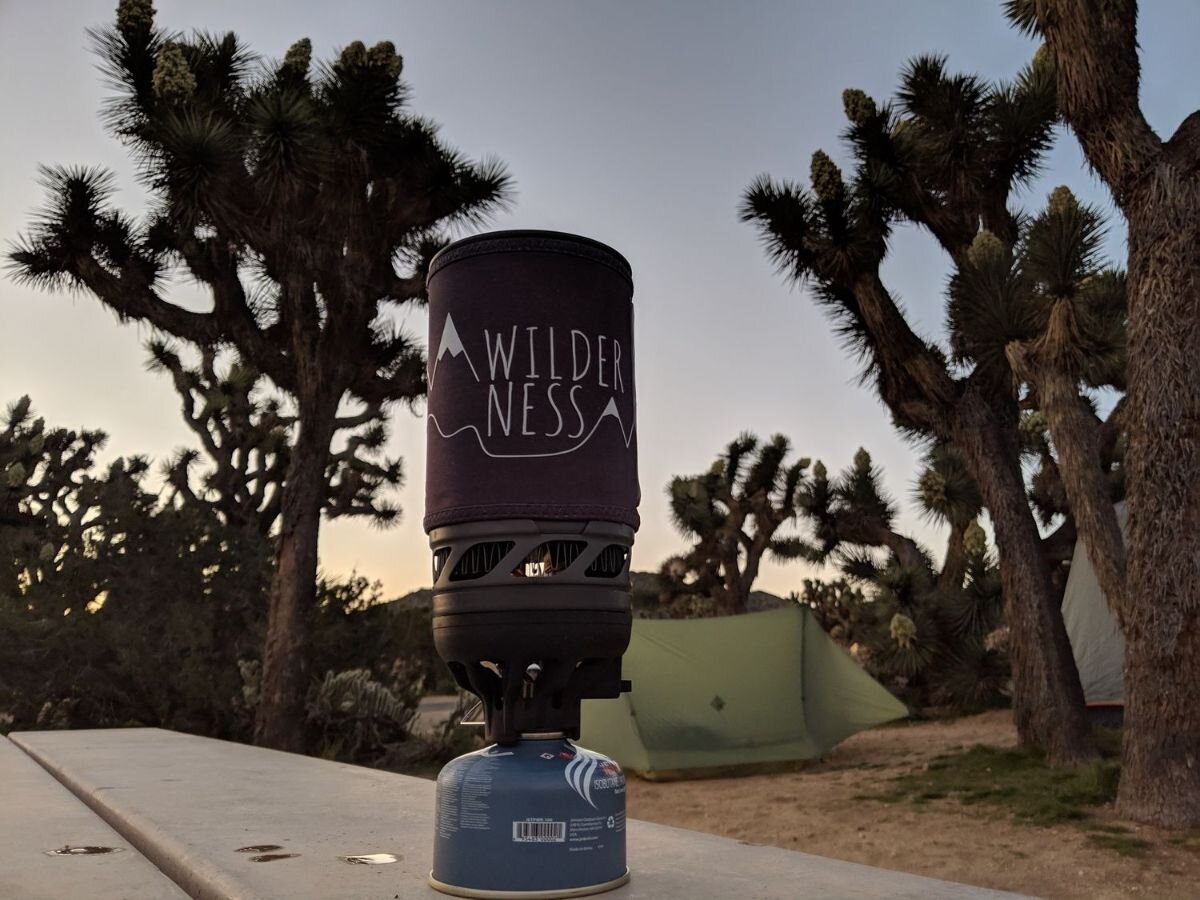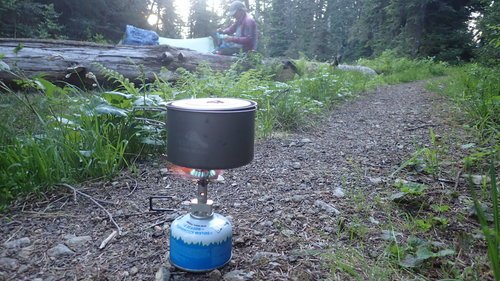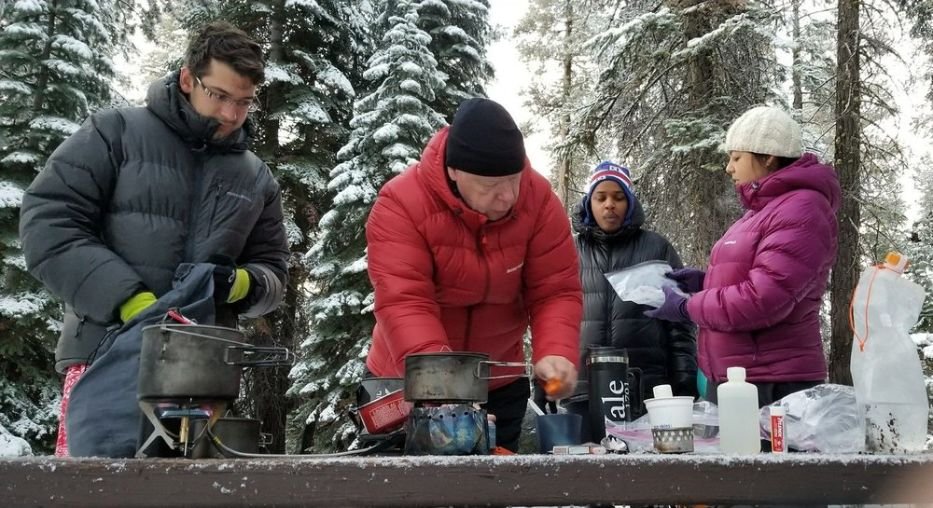Best Backpacking Stoves of 2023
lightweight, windproof, fast boiling stoves for backpacking and thru-hiking
March 21, 2023
The best backpacking stove should be lightweight, stable, easy to use, durable, and will serve you well in wind, cold, and altitude. We researched 22 of the most popular backpacking stoves and spent 4 years backpacking 5,000+miles in 8 states to find the best lightweight backpacking stove for most people.
We rated each backcountry cooking system based on how easy they are to handle when hot, and if they were compact and ultralight enough to fit into a backpack. We also considered features like regulators and igniters as well as integrated stoves with quality built-in cook pots. See our guide on How to Choose a Backpacking Stove for all the criteria to look for in a backpacking stove.
Warning: Reading this article is not a substitute for reading the directions! You’re responsible for your own safety so PLEASE read the instructions on your stove before use.
Need a cookpot? See our guide to the Best Cookpot for Backpacking
Making your own backpacking meals? See our Best Food Dehydrator for Backpacking
We create reader-supported, objective gear reviews independently selected by our editors. This story may contain affiliate links, which help fund our website. When you click on the links to purchase gear, we may get a commission — without costing you an extra cent. Thank you for supporting our work and mission of outdoor coverage for every body! Learn more.
Comparison TABLE
| BACKPACKING STOVE | TREELINE AWARD | WEIGHT (OZ) | INTEGRATED POT? | FUEL TYPE | BOIL TIME (1L) | SIMMER? | AUTO IGNITION? | PRESSURE REGULATOR? |
|---|---|---|---|---|---|---|---|---|
| MSR Pocket Rocket Deluxe | Best overall Read why |
2.9 | No | Canister | 3 minutes, 18 sec | Yes | Yes | Yes |
| Soto Windmaster | Best windproof Read why |
2.3 | No | Canister | 4 min 2 sec | Yes | Yes | Yes |
| Jetboil MiniMo | Best integrated Read why |
14.0 | Yes | Canister | 4 min 30 sec | Yes | Yes | Yes |
| MSR WindBurner Duo | Best for groups Read why |
21.1 | Yes | Canister | 4 min 30 sec | Marginal | No | Yes |
| BRS-3000T | Best budget Read why |
0.9 | No | Canister | 4 min 45 sec | Yes | No | Yes |
We note any discounts we see on our Deals page, which is updated daily.
The Best Backpacking Stoves
THE BEST BACKPACKING STOVE FOR MOST PEOPLE: MSR POCKETROCKET DELUXE
Weight: 2.9 ounces
Push start integrated piezo igniter button: Yes
Pressure regulator: Yes
Integrated pot: No
Fuel type: Canister
Fuel source: Isobutane-propane
Average boil time (1L): 3 minutes 18 seconds
BTUS: 11,000 BTU
Water boiled per 8-oz canister: 17 L
What we liked: easy to use, durable, easy puezo igniter, versatile, very fast boil
What we didn’t like: not as windproof as other stoves, not as fuel efficient as other stoves
After more than two years of testing, we believe that the MSR PocketRocket Deluxe is the best lightweight backpacking stove for most people. The MSR PocketRocket Deluxe’s excels at all the criteria we set—from boil time to simmer mode—and is the best for ease of use and durability durability. From its igniter to its pressure regulator (which ensures a consistent flame even in the cold or when the fuel canister is low), this feature-packed stove delivers a lot in a compact package.
The PocketRocket Deluxe improves on the features we loved in our winner for the past two years, the MSR PocketRocket 2. The Deluxe won us over with its faster boil time, increased windproofing, and the same durability and simplicity of our former pick. The Deluxe is the unanimous favorite of almost all the professional reviews we scanned and was the lightweight backpacking stove used by nearly every thru-hiker we encountered on our John Muir Trail thru-hike.
COMPARE PRICES ON THE MSR POCKETROCKET DELUXE
The MSR PocketRocket Deluxe is among the most straightforward and small backpacking stoves to use. Photo by Liz Thomas.
We found that the MSR PocketRocket Deluxe is among the most straightforward to use of the lightweight backpacking stoves to use (falling short only of the Snow Peak GigaPower).
While all canister stoves are relatively easy to use once you get the hang of them, we’ve seen too many backpackers struggle with their stove system and opt not to eat because of it (read more on why we think ease-of-use is the most important feature when picking a stove.) This makes the Deluxe’s ease of use a major win: a first-time backpacker and an expert too tired to see straight can both get the Deluxe up and running.
The MSR PocketRocket Deluxe is a durable and reliable hiking camp stove, while not feeling overbuilt. Like the PocketRocket 2, the Deluxe’s simple design doesn’t have delicate parts that can snag, or break off.
What makes using the Deluxe (and the PocketRocket 2) so easy is that the pot-stand arms go in two directions: up to hold a pot and down to stow away. The arms don’t fold on themselves like the phalanges on your finger (as on the Snow Peak LiteMax). This means fewer parts to break or get stuck.
This photo documents the last boil of this empty fuel canister, which gave us hot water quickly and then refused to burn again. The pressure regulator means time to a full boil is consistent whether you’ve got a new fuel canister full of pressure or are whether your fuel can is near-empty. Photo by Liz Thomas.
When it comes to pot stand arms, there’s a fine line between super stable and feeling stuck in place—and the Pocket Rocket Deluxe nails the sweet spot.
Stable arms won’t wobble if you accidentally brush against the pot or place the stove on less-than stable ground (don’t do this). But if the joints along the arms are too rigid or stick in place (like on the Optimus we tested), they can be frustrating to open and close, especially with cold, numb hands.
Even after accumulating a years’ worth of trail crud, the joints on my MSR PocketRocket Deluxe stay in place without feeling like they’re stuck to the rivets. The MSR has among the best teeth on the arms of the stoves we considered (though they’re better on our upgrade pick, the WindMaster). These teeth create additional contact between the arm and the pot.
MSR POCKETROCKET 2 VS MSR POCKETROCKET DELUXE
The PocketRocket Deluxe builds on the PocketRocket 2 by adding many of the features found in stoves twice the price and weight. MSR delineates the differences between the two stoves here.
Though the Deluxe is more expensive, we think these benefits are well worth it.
A close-up of the Deluxe’s teethed arms and push button start at a campsite in Mesa Verde National Park, Colorado. Photo by Liz Thomas
PUSH START PIEZO IGNITOR
The push start integrated ignitor button (aka, piezo) on the Deluxe means that you don’t need to hold a lighter next to the stove to get the burner going. This eliminates a step many backpackers find intimidating when using camp stoves. While igniters notoriously fail, we found the piezo ignitor on the Deluxe to be reliable (however, we ALWAYS recommend keeping a lighter and/or matches handy just in case and to avoid getting your stove wet).
PRESSURE REGULATOR
The Deluxe also features a pressure regulator, a feature usually found in bulkier and more expensive stoves. The pressure regulator means that in colder conditions or when the fuel canister is low, the stove will deliver a consistent flame. This means that boil times will be more consistent from boil-to-boil compared to most other minimalist camp stoves we tested. While the stoves in this guide are designed for 3-season use, a pressure regulator could stretch it into mild 4-season use.
Close-up of the burner head on the Pocket Rocket Deluxe, which is much more wind resistant than the Pocket Rocket 2 (our former winner for Best overall stove). Photo courtesy Liz Thomas.
WINDPROOFNESS
The PocketRocket Deluxe design is more windproof than the PocketRocket 2. It has a broad burner head with a wind lip somewhat similar to our windproof upgrade pick, the Soto Windmaster. Our main gripe with the PocketRocket 2 is that it doesn’t work well in the wind. We found that the Deluxe improves on the PocketRocket 2’s design and although it still isn’t as windproof as the Windmaster, it’s better than most other stoves we tested, including the PocketRocket 2.
SIMMER CONTROL AND COOK SPEED
The simmer control on the Deluxe is better than on the PocketRocket. It was able to hold food at just below a boil for extended periods by controlling the flame with a half-turn of the control valve. Only the GigaPower was easier to use for simmering.
The PocketRocket Deluxe is capable of cooking at 11,000 BTUs (aka 2800 kcal/h 3260w 11000 BTU). It cooks significantly hotter (and thus faster) than most of the stoves we considered, except the Soto Windmaster.
NOISE
The PocketRocket Deluxe is less noisy than the PocketRocket 2. I’ve heard some backpackers complain that the PocketRocket 2 jet can block out conversation. The newer Deluxe can be loud on full heat but can be made quieter when needed.
We think the MSR PocketRocket Deluxe is the best backpacking stove because of its simplicity. Compared to our former winner, the PocketRocket 2, the piezo ignitor on the Deluxe adds to its simplicity by eliminating the extra 30 seconds of searching for your Mini Bic to light the stove. When you’re that tired, the fewer steps between you and food, the better.
BEST windproof BACKPACKING STOVE: SOTO WINDMASTER STOVE WITH 4 FLEX
Weight: 2.3 ounces
Push start integrated ignitor button: Yes
Pressure regulator: Yes
Integrated pot: No
Fuel type: Canister
Fuel source: Isobutane-propane
BTUS: 11,000 BTU
Average boil time (1L): 4 minutes 2 seconds (1 L)
What we liked: extreme windproofness, fast boil, igniter that never dies, modularity allows for use on solo pots or big group group pots, cooks hotter and faster than other stoves
What we didn’t like: not as fuel efficient as some stoves, not as intuitive to use
We think the Soto WindMaster Stove with 4 Flex is the best windproof stove because it is the lightest, most versatile, most wind-resistant stove we tested. Even when you’re out of the wind, there’s a lot to love about the Soto, which won the American Alpine Institute Guide’s Choice Award as well as the most popular ultralight backpacking stove among Pacific Crest Trail thru-hikers. We’ve thru-hiked thousands of miles with this stove and it’s the one we reach for the most.
The durable and well-made WindMaster has a sturdy, flat pot stand with teeth that grip the bottom of your cooking pot. It’s also a great value (less expensive than our overall winner). It can accommodate solo or group-sized pots, making it versatile for different trips. But it isn’t our overall recommendation because it has a steeper learning curve than other stoves. We think the Soto WindMaster is an excellent choice for someone who plans to use their hiking stove a lot and is willing to practice the setup at home before going on a trip.
COMPARE PRICES ON THE SOTO WINDMASTER
The Soto WindMaster on a section of the Pacific Northwest Trail in eastern Washington. Photo by Liz Thomas.
While we often find that the push-button ignition (aka, the piezo) fails on upright canister stoves, Soto’s is considered the best in the industry due to its protected design (it doesn’t leave out any hanging parts that can catch, become loose, or fill with trail gunk). Still, a separate ignition is one of the Ten Essentials, so we’ll keep carrying our Mini Bic Lighter.
Like its award-winning and earlier-model cousin, the Soto Micro Regulator, the WindMaster has a pressure regulator that’s considered among the best in the industry. The regulator means that the Windmaster regulates the pressure of the gas release from your canister, so it can work better in cooler temperatures than stoves without regulators.
Both the WindMaster and the Micro Regulator are capable of cooking at 11,000 BTUs (aka 2800 kcal/h 3260w 11000 BTU). It cooks significantly hotter (and thus faster) than most of the stoves we considered, except the PocketRocket Deluxe.
The WindMaster has a sturdy, flat pot stand with teeth that grip the bottom of your cookpot. It can accommodate solo or group-sized pots (as shown with a 3L pot above), making it versatile enough for trips alone or with friends and family. Photo by Liz Thomas.
SOTO WINDMASTER VS MSR POCKETROCKET
The Soto WindMaster was the best of the stoves we tested for boiling water in 30 mph wind, managing to give us hot water in 5 minutes in 30 mile per hour winds (vs. the MSR PocketRocket 2, which performed so poorly that we gave up and drank lukewarm coffee). The way the Windmaster excels in the wind is that the burner head is recessed--it’s shaped in a concave manner that pushes heat up. This is in contrast to the drastically convex-shaped open burner head like on the Optimus Crux Lite that we tested.
The major upside — and downside — of the WindMaster is that it comes with a detachable pot support.
First, the downside: To use the WindMaster stove, you need to snap on the pot support, which takes some spatial skills. As someone with poor spatial skills, I generally don’t like gear that requires assembly in the field. Adventures with Stoving recommends linking your detachable pot stand to your pot via a micro-carabiner to prevent losing that part (it’s, unfortunately, a brownish color that blends in well with dirt).
The Soto Windmaster is the only stove that we considered that can handle both small, solo cook pots and large, group cook pots, skillets, and frying pans. Here, it is frying up a breakfast of potatoes and zucchini in the White Mountains, CA. Photo by Liz Thomas.
The upside of the detachable pot support is that it makes the WindMaster one of the most versatile stoves around. You can use it on small solo pots or convert it to hold 2L pots for group trips. We’ve used the Windmaster from the Arizona Trail to Pacific Northwest Trail, in cold windy rain and summer monsoon wind. The WindMaster, despite its learning curve, will not disappoint those willing to put in some extra time to learn how to set it up.
THE BEST INTEGRATED BACKPACKING STOVE: JETBOIL MINIMO
Weight: 14 ounces (includes cooking pot)
Push start integrated ignitor button: Yes
Pressure regulator: Yes
Integrated pot: Yes
Fuel type: Canister
Fuel source: Isobutane-propane
BTU: 6000 BTU
Average boil time (1 L): 4 minutes 30 seconds
What we liked: fits fuel canister inside, fast boil, ease to use, space efficient, all-included, simmering, insulated rubber handles and side-body, a pressure regulator to keep fuel use consistent in the cold, includes pour spout in lid
What we didn’t like: price, heavier than non-integrated stoves, system locks to canister when hot making it harder to poul water, pour spout could be better angled
The Jetboil MiniMo is the best integrated stove that we considered and a favorite of almost all the professional reviews we analyzed. With the MiniMo, Jetboil builds on the easy-to-use design of its original Flash cooking system and creates an all-in-one stove (minus fuel) that is relatively lightweight, very fast, fuel-efficient, and space-efficient.
The Jetboil MiniMo comes with a pot, piezo igniter, and stove, so if you get this system, you don’t need anything else, which makes it a convenient system for those who aren’t sure what they want. It’s a bestseller and favorite of experts and customers alike, getting praise from media like the REI Co-op journal. It’s also known for being among the best integrated cooking systems for simmering and precision cooking. That’s why the MiniMo is one of the most common stoves on the Appalachian Trail, where thru-hikers value convenience and being able to cook up food quickly while occasionally simmering up soups or slower cooking meals.
COMPARE PRICES ON THE JETBOIL MINIMO
The Jetboil MiniMo builds on the success of the classic Jetboil Flash system but is more compact, making it easier to store in a backpack. Here, we tested the MiniMo on a section hike of the Sierra High Route. Photo courtesy Liz Thomas.
What we liked about this Jetboil is that is it is compact. It fits better into the front mesh of a backpack than other integrated stoves we tested. The MiniMo is also less tippy and more stable than the Jetboil Flash, while also being easier to disassemble and clean than other camp stove systems. The main drawback of this Jetboil stove is its price and how it fares in the wind (though it performs similarly to our main winner, the MSR PocketRocke Deluxe).
We also like that the Jetboil MiniMo is a small canister stove and less bulky than other integrated stove systems (with the exception of the Stash—see review below). Many stoves and cook pots are awkward sizes that don’t fit well into backpack pockets. In contrast, the Minimo conveniently fits inside the mesh or water bottle pockets in a backpacking backpack.
Treeline senior editor Brandon Lampley finds this the most exciting part of the Jetboil MiniMo system: “To me, the major benefit of carrying the stove in an outside pocket...is hot drinks or hot lunch on the go. Plus, quick hot drinks as soon as you stop to camp.” Lampley finished his PCT thru-hike in late October. When camping in cooler weather, a quick hot drink during breaks or lunch can be a morale booster and motivator to push on.
The MiniMo comes with a pot, piezo igniter, and the stove, so if you get this system, you don’t need anything else—which makes it a convenient system for those who aren’t sure what they want. Here, the author tests it on a backpacking trip in the San Gabriel mountains.
While every backpacker packs differently, an integrated stove system often takes up valuable pack real estate in a water bottle pocket or hangs awkwardly on the top of the pack, where a dirty or wet pot can mess with your other gear. With the Jetboil MiniMo, the bottom screws off easily (although it could be easier) and fits inside the pot along with a sideways-oriented fuel canister.
The MiniMo’s system is a far more efficient use of space than any other integrated canister stove system. With the Jetboil MiniMo, your pot will protect your camp stove from getting clogged with dirt and from the metal parts from your stove, which can potentially damage soft goods gear. (Although, compared to the arm supports and leg supports found on other stoves, the MiniMo system has the least sharp edges of the stoves we tested).
The Jetboil Flash (left) and MiniMo (right) in coffee mode at a campground in Joshua Tree. The MiniMo is so fast and easy to use, that it will likely become your favorite for camping trips when your camp stove burners are limited and more coffee is required. Photo courtesy Liz Thomas.
JETBOIL MINIMO VS. JETBOIL FLASH
Part of what makes the Jetboil MiniMo the best backpacking stove is its shape: a squat size 1 L pot vs. the more traditional “beer mug” shape of the Jetboil Flash or MSRs we tested.
Coils underneath the MiniMo pot give it a quick boil time. Outdoor Gear Lab found that the MiniMo has a relatively fuel-efficient system and speedy boil time (4:06 to boil a liter, the second-fastest of those we tested after the Jetboil Flash). But that short height also means it’s also quite stable. That short-sized pot also means the Jetboil MiniMo doubles nicely as a bowl — one that doesn’t require a long-handled spoon!
The Jetboil MiniMo is the best Jetboil for backpacking because of its packable shape and size. A similar packable shape and size can be found in Jetboil’s newest stove, the minimalist-friendly Stash. However, the Stash doesn’t have the user-friendly features of the MiniMo including a push-button ignitor, insulated rubber handles and side-body, and a pressure regulator to keep fuel use consistent in the cold.
WHAT IS THE BEST JETBOIL STOVE?
Close-up on the small gap in the insulation cover on the MiniMo. Photo courtesy Liz Thomas.
Unlike every other integrated canister stove we tested, the MiniMo has actual metal pot handles with rubber insulation (so they don’t feel hot — though some customers complain that the joints can burn you).
We much prefer MiniMo’s system to the insulated koozie sleeves on Jetboil’s other stoves, which can melt or otherwise be difficult to get your hand in just right (at least in the dark). Customer reviewers and our own testers found that the MiniMo could use more insulation adjacent to the handles. While the handles are solid and cool, if you accidentally touch the pot near the handles, that area can burn you if hot. The MiniMo also lacks the side panel indicator found on the Jetboil Flash (it turns red to let you know the water has boiled).
An annoying feature of the Jetboil MiniMo and many other integrated stoves is that there’s no easy way to remove the pot from the canister when there’s hot liquid inside. Read the manual for more on this. Customer reviewers and our own testers found that the system seems to lock down when hot. You have to pour water from your pot with the canister still attached. But still, the cooled MiniMo system was much easier to disassemble for cleaning or eating than the Jetboil Flash. If you know this will bother you, we recommend the Jetboil Stash instead because it easily detaches while still having the efficiency of other Jetboil systems.
Our testers also thought the pour spout that comes with the lid could be better angled and more generous, but honestly, we recognize just having a pot lid with a pour spout is rare and exciting in the gear world.
Unsurprisingly, Outdoor Gear Lab dinged the MiniMo for not being great at simmering (though they still thought it was the best of the integrated systems). We tried real-real cooking with the add-on pot support that allows your Jetboil MiniMo to work with non-Jetboil pots and pans. The converter piece has a lot of sharp edges that need to be hooked into the burner to work as a stable pot support. Knowing that everything had to be snapped in just right to not create an unstable situation over the JetBoil burner made the process intimidating. However, it gets somewhat easier with practice. Customer reviewers also complained that because the bottom of the pot isn’t non-stick, it’s hard to clean food that has been real-cooked in there.
Hands down, the most common complaint among reviewers is that Jetboil’s piezo ignition stopped working. We know this happens to almost every hiking stove eventually. We suggest whatever stove you have, bring an extra lighter, and never expect much of a piezo. Unlike on some other stoves, the piezo on the Jetboil MiniMo isn’t easy to fix. Lighting the Jetboil isn’t as easy to do as the MSR PocketRocket, but it’s do-able.
The Jetboil MiniMo (and the Jetboil Flash) have add-on French Press components that felt luxurious while car camping and minimal enough that I could’ve seen myself carrying one on a backpacking trip. The French Press Kit adds 1.05 oz to the MiniMo. That’s really lightweight—the coffee you carry will be heavier than the French Press.
The Jetboil MiniMo is an excellent pick for someone who wants a quick, easy, and simple system. It’s among the highest-rated stoves on REI (4.4/5 stars over 314 reviews) and Amazon (4.5/5 stars over 101 reviews) and the best integrated canister stove, according to REI Co-op Journal and Outdoor Gear Lab.
It’s also one of the most common stoves on the Appalachian Trail, where thru-hikers value its simplicity and packable design. For its speed and ease of use, the Jetboil MiniMo is the best backpacking stove for most folks who want an integrated pot design.
BEST BACKPACKING STOVE FOR GROUPS: MSR WINDBURNER DUO
The MSR WindBurner 1.8 L version with included components. Notice the remote canister.
Weight: 21.1 ounces
Integrated pot: Yes
Ignitor: Yes
Fuel type: Canister
BTU: 7000
Fuel source: Isobutane-propane
Average boil time (1L): 4 minutes 30 seconds
What we liked: Extreme windproofness, works well in cold conditions, biggest capacity integrated stove we found, modularity allows for group and solo use without additional equipment, fast boil, stability, ease of use
What we didn’t like: weight (although it’s quite good for a group stove), slower boil (but only by a few seconds)
The MSR WindBurner Duo is great for situations when you’re in charge of group cooking for a lot of people and want a quick system that is windproof and simple to use. The WindBurner shows up as a highly recommended stove on almost every professional review we considered. But its extra price, bulk, and weight make it best for situations where you really need a stove of this caliber: when you’re in charge of scouts, a group of friends you’re taking outdoors, clients you’re guiding, or taking family or friends out overnight.
COMPARE PRICES ON THE MSR WINDBURNER DUO
The MSR WindBurner is a taller stove whose burner is held up by a multi-legged support. The Duo works with both the 1.8 L pot (left) and 1 L pot (right) as well as the WindBurner Sauce pot and WindBurner Skillet. Photo by Liz Thomas.
MSR REACTOR VS MSR WINDBURNER
Built around the same technology as the award-winning MSR Reactor, the WindBurner shares many similarities with that designed-for-mountaineers stove. The windproof burners on the two stoves are similar, but the WindBurner is designed to use fuel more efficiently with several features that make it more tailored to ease-of-use than the utilitarian Reactor. It’s also significantly less expensive than the Reactor.
As you can imagine from its name, the WindBurner’s major perk is that it can still function in high winds. By reducing the effect of wind, it burns more efficiently and boils faster.
However, the WindBurner Duo is a remote canister stove, which gives it better stability over the Reactor. (Note that the WindBurner Personal doesn’t have the remote canister, so isn’t quite as stable).
The WindBurner also has an insulated sleeve and handle. Although these are minor additions, they give it a much more user-friendly design than the Reactor.
The WindBurner Duo takes everything we like about the Reactor and makes it more user-friendly for those in charge of groups who are cold, hungry, and need a morale boost in the form of hot food.
However, without wind, according to Outdoor Gear Lab’s data, it’s one of the slower burners (fuel efficiency often means slower boils). Oddly, in our personal tests, it always seemed to burn faster than the MSR PocketRocket.
Adventures in Stoving liked the MSR 1.8 L WindBurner over the similarly-sized option available from JetBoil, although he finds the weight hard to justify if you don’t see wind in your future.
The WindBurner is an intuitive system. Unfold the legs, plop the stove on the burner, and screw the canister into the end of the satellite piping system. That’s right. Unlike the other stoves we considered, the WindBurner is a remote canister stove.
The fuel piping system cuts down on the system’s height (it’s already the tallest we reviewed) and makes it more stable. While some reviewers complained that the pot doesn’t screw in securely to the base, we liked that feature. It made it much easier than the MiniMo to handle while hot (though it still must be done with care).
The Windburner stores fuel. Photo courtesy Liz Thomas.
While guiding in Big Sur in the pouring rain in February, I kept the WindBurner constantly going to supply folks with morale-boosting hot tea and miso soup. The WindBurner ran all night long, supplying hot water faster than individual backpacking stoves and creating a sense of together-ness as we suffered through the rainy evening together.
We also tested in during a winter group hike in Central Oregon where we stopped trail-side to make everyone hot coffee. It made the trip even more delightful and pumped out large quantities of water quickly so no one had to wait their turn to get served.
Another huge advantage of the WindBurner 1.8 L is its modularity. You can use the same stove base for the 1 L WindBurner cooking pot. The 1 L cooking pot plops onto the WindBurner’s base just as well as the giant 1.8 L pot. This means you can convert your group system to a solo or couple’s system without having to buy a whole new integrated canister system. The 1 L WindBurner cookpot is 2/3rds the price of all the least expensive integrated systems we considered, so choosing the 1L accessory pot offers some cost savings if you’re ok with the weight.
There are a few things to quibble about on its design. The WindBurner is bulky and heavy. It’s hard to find a spot that the 1.8 L system will fit in a backpacking backpack. In addition, we don’t like that the handle is made of fabric. It’s hard to get a gloved hand into the right spot when doing it in the dark.
MSR WHISPERLITE VS. WINDBURNER 1.8 L
We prefer the MSR Windburner 1.8 L to the MSR WhisperLite for a group stove because of its speed of cooking and ease of use. However, if you plan gourmet cooking like onions or steaks, go with the Whisperlite.
Close up of the burner on the Windburner stove. It’s similar to the burner on the MSR Reactor, which is a bestseller designed for mountaineers who want to boil water above treeline. However, the Windburner is more fuel efficient and affordable than the Reactor, so is better-suited for all but the most extreme trips. Photo by Liz Thomas
Which stove you use for your group depends on how you intend to use the stove. Will you be doing any gourmet cooking? How quickly do you need hot water? Where are you guiding?
The WindBurner can’t be used as a gourmet cooking system. The WindBurner also doesn’t have as much temperature control as the WhisperLite. If you want to sauté, go with the WhisperLite.
The WhisperLite is also a better option if you are guiding somewhere where fuel canisters may be difficult to find. The WhisperLite International runs on liquid fuel, including white gas, kerosene, and even unleaded gasoline. Liquid fuel stoves require you to reuse and refill the same fuel bottle, cutting down drastically on waste compared to pressurized fuel canisters. An empty fuel bottle also weighs considerably less than an empty isobutane canister. Notably, a liquid fuel stove is usually much easier to repair in the field than a canister stove. For more on liquid fuel, see our section on What is the Best Fuel for Backpacking Stoves?
Still, we think for most group trips, the Windburner will serve you better. When you need hot water for a big group in inclement weather, the WindBurner can do that job more quickly. In contrast, the WhisperLite requires priming liquid gas before use, which has a steep (and potentially explosive) learning curve. The Windburner can be used much more safely and as the name suggests, it’s going to be a lot faster to boil time on a windy day.
best budget backpacking stove: BRS 3000T
Weight: 0.9 oz
Integrated pot: No
Ignitor: No
Pressure regulator: No
Fuel type: canister
Fuel source: Isobutane-propane
Average boil time (1L): 4 minutes 45 seconds
What we liked: price, lightweight
What we didn’t like: slow boil time, learning curve, cannot handle high heat
For a fraction of the cost of the other stoves, the BRS 3000T ultralight backpacking stove is among the most loved stoves among customer reviewers and professionals. It scores 4.5/5 stars of about 200 reviewers on Amazon and is recommended as the best budget stove by Sectionhiker and Outdoor Pursuits. Several Treeline Review writers and editors have bought and used this stove for thousands of miles and have found it a good bang for the buck—if you learn how to use it correctly.
COMPARE PRICES ON THE BRS 3000-T STOVE
The BRS 3000T is an ultralight backpacking stove with many positive reviews including from our friend Scott “Shroomer” Williams, whose set-up is shown here. It has traveled thousands of miles with him on numerous backpacking trips domestically and internationally. Photo courtesy Scott Williams.
For anyone interested in the BRS, it’s essential to learn its flaw: it can’t operate at full power lest it melt the arms of the stove. Several BRS devotees that we interviewed say that flaw is more-or-less an open secret that they knew going into the purchase. They said they’re ok using a stove that they know can only operate at 75% power.
We found operating the BRS at 75% to be plenty powerful to boil water and simmer food. It’s slower to boil than almost any other stove we considered. But the BRS is a lightweight stove that is easy to use and inexpensive.
While there’s a lot to like about this stove, consider the safety hazards and ALWAYS READ AND FOLLOW THE INSTRUCTIONS.
We tested the Jetboil Flash while camping in Joshua Tree National Park. Photo courtesy Liz Thomas.
HONORABLE MENTION BACKPACKING STOVES
Here are some of the other stoves we tested that we think are worth being on your radar. Even if they aren’t necessarily the best stoves for most people, they may meet your needs better than our winners.
See the Comparison Table to see how all the stoves measure up side-by-side.
The MSR Pocket Rocket was our overall best backpacking stove for 2 years running. Here, we enjoyed using it on the 1,200-mile long Pacific Northwest Trail in Idaho. Photo courtesy Liz Thomas.
Weight: 2.6 oz
Integrated pot: No
Ignitor: No
Pressure regulator: No
Fuel type: Canister
Fuel source: Isobutane-propane
Average boil time (1L): 3 minutes, 30 seconds
We’ve carried the MSR PocketRocket 2 for more than 100 days of dinners and morning coffee and continue to pack it on most of our trips. Almost every person who writes or edits for Treeline has purchased and continued to use this backpacking stove.
Adventures in Stoving calls it “dead simple,” “beefy,” with a design where there is “nothing to go wrong with it” as well as “simple, strong, and reliable.” The PocketRocket 2 is a hassle-free, intuitive backpacking stove that doesn’t require babying, but still performs better than its competitors in most conditions.
However, after a year of testing the PocketRocket 2 against the PocketRocket Deluxe, we find ourselves continually reaching for the Deluxe instead. The addition of the piezo ignitor makes the Deluxe easier and more intuitive to use. The shape of the burner on the Deluxe also makes it more windproof than the PocketRocket original, though not as good as the Soto Windmaster.
The PocketRocket 2 has been a handy standby for years, like a trusty pair of socks that never lets you down. I still keep my old one in my camping kit as a back-up. But the Deluxe’s features are more convenient. We think if you’re only going to buy one stove, the Deluxe’s features are worth it.
COMPARE PRICES ON THE MSR POCKETROCKET 2
The Snow Peak Gigapower on a cold and beautiful November morning at the hot springs in the Eastern Sierra. Photo by Liz Thomas
Weight: 3.2 oz
Integrated pot: No
Ignitor: Yes
Pressure regulator: No
Fuel type: Canister
Fuel source: Isobutane-propane
Average boil time (1L): 4 minutes 48 seconds
The Snow Peak GigaPower 2.0 Auto is arguably the easiest to use stove and is the best stove for temperature control for those who want to do gourmet cooking in the backcountry. Its design is like a work of art, and it is much loved by professional reviewers. The GigaPower is also incredibly durable.
But compared to the MSR PocketRocket Deluxe, it has extra weight, bulk, and slower boil time. Because it doesn’t have a pressure regulator, boil times are less consistent when in cold temperatures or when the fuel canister is low. We think most backpackers wouldn't be bothered if one of those stats were true, but all four pushed it down in rankings for us.
For those looking to save a little more, the GigaPower 2.0 is also available in a manual version. This version does not have an igniter.
COMPARE PRICES ON THE SNOW PEAK GIGAPOWER 2.0
The Jetboil Stash’s is a compact stove system. It includes the pot and the fuel canister and stove both fit inside for easy carrying in a backpack. Photo by Liz Thomas
Weight: 7.1 oz (includes pot)
Pot included: Yes
Ignition: No
Fuel source: Isobutane-propane
Power: 4500 BTU/h / 1.32 kW
Pressure Regulator: No
Boil Time: 5 minutes (1 L)
In 2021, Jetboil released one of the most anticipated stoves on the market, the Jetboil Stash. The Stash is part minimalist canister stove, part integrated stove. As a result, the Jetboil Stash takes the best parts of both kinds of stoves. It’s lighter and more compact than any other integrated stove on the market, including our winner for integrated stove, the Jetboil Minimo. Yet, the Stash has the fuel efficiency of an integrated system. That’s one reason it almost immediately sold out after its release.
The base of the Stash has a similar design to the MSR PocketRocket or other non-integrated canister stoves. However, the cooking pot looks more like the screw-on pot of the Jetboil Flash or Jetboil MiniMo. It uses Fluxring technology for a heavier but more fuel-efficient heat transfer. Where the Fluxring technology really shines is in fuel efficiency-getting 12 L of boil out of a single 100 g fuel canister.
The pot also doesn’t screw on like the Flash or MiniMo meaning it’s easy to remove — a benefit compared to true integrated systems. At 7.1 oz, the .8L Stash is 40% lighter than Jetboil’s lightest stove, the .8L Jetboil Zip. In weight, it’s pretty comparable to carrying a lightweight canister stove and a titanium cookpot.
Another aspect where the Jetboil Stash excels is the ability to fit both the fuel canister and the stove base into the pot. This was a feature we liked with the Jetboil MiniMo, but it works much better on the Stash. In fact, when you buy the Stash, it comes with an empty fuel can-shaped trinket case just to show off how well everything fits together in the pot.
The downfall of the Stash is that it doesn’t have an ignitor, a common complaint in customer reviews. All Jetboils up until now have had ignitors, so the departure hit some backpackers hard.
Additionally, many customers complained that the Stash doesn’t function well in the wind. As with the ignitors, all Jetboils so far have been known for their windproofness. We hope that in future design updates, the Stash integrates a more windproof lip or concave system that protects the flame from wind better.
COMPARE PRICES ON THE JETBOIL STASH
The Snow Peak LiteMax tested on a section of the Boundary Trail in the Pasayten Wilderness. Photo courtesy Liz Thomas.
Weight: 1.9 oz
Integrated pot: No
Ignitor: No
Fuel type: Canister
Fuel source: Isobutane-propane
Average boil time (1L): 4 minutes 25 seconds
The Snow Peak LiteMax Titanium is a well-designed, ultralightweight, and very compact stove with arms that unfold like a piece of Origami. Thus, its beauty (and what makes it so well-beloved by Switchback Travel, Outdoor Gear Lab, Sectionhiker, and Greenbelly) is also its downfall. We don’t think that a stove that requires that much folding is a good first stove.
The Snow Peak LiteMax is great for those who like to nerd out about stove specs. But if you’re simply looking for something easy and simple to cook your food on, we think the LiteMax’s bulkier brother, the Snow Peak GigaPower 2.0, will serve you better.
COMPARE PRICES ON THE SNOW PEAK LITEMAX TITANIUM
Weight: 2.9 oz
Integrated pot: No
Ignitor: No
Pressure Regulator: No
Fuel type: Canister
Fuel source: Isobutane-propane
Average boil time (1L): 3 minutes
We took the compact Optimus Crux camping stove for 1,200 miles of backpacking on the Pacific Northwest Trail. Rated at 10,200 BTUs, it’s notably quicker at cooking than the MSR PocketRocket 2 but is less fuel-efficient. In our tests, its concave design also makes it less wind-resistant than our upgrade pick, the Soto WindMaster (and even less wind-friendly stoves like the Snow Peak LiteMax). We also found that the large burner and lack of pressure regulator make it especially sensitive to changes in fuel canister pressure. Even in mild ambient temperatures, the flame sometimes goes out as the pressure of the fuel canister changes.
Additionally, in a series of stability tests by Adventures in Stovin’, the Crux didn’t fare as well as the PocketRocket. That’s consistent with our experience in the field. The joints on the Crux’s pot support arms perpetually feel stuck, requiring yoinking to get open (and pushing to close). The Optimus Crux Lite is a solid choice and has been trusted for many years, and while we don’t think you can go wrong with it, the PocketRocket meets our criteria better.
One thing we absolutely loved about this stove: the unique folding design of the burner head. It folds down and, with its storage bag, will fit in the bottom of your fuel canister. Hands down one of the better innovations we’ve seen in stoves.
The slightly lighter and non-folding Optimus Crux Lite is often sold as part of a kit with the Terra Solo Backpacking System. It’s one of the better packing compact stove+pot systems we’ve seen.
VIEW THE OPTIMUS CRUX
The Jetboil Flash has a temperature-changing indicator on its sleeve that goes from blue to red when the water is boiling hot. Photo courtesy Liz Thomas.
JETBOIL FLASH
Weight: 13.1 oz
Integrated pot: Yes
Ignitor: Yes
Pressure Regulator: Yes
Fuel type: Canister
Fuel source: Isobutane-propane
Average boil time (1L): 3 minutes 20 seconds
The relatively inexpensive Jetboil Flash is the base model integrated canister, but we think it's worth paying extra for the features found in its sibling, the Jetboil MiniMo.
The Flash is the best backpacking stove for boiling water quickly. But the Jetboil Flash’s beer-mug shape makes it bulky to fit anywhere in a backpack, difficult to eat from, and less stable. The Jetboil pot also snaps into the stove so well that it is difficult to detach the two pieces. While the Jetboil Flash is the less expensive cousin of the Jetboil MiniMo, we think the MiniMo is a better stove option.
One perk of the Jetboil Flash is that it’s available as a Jetboil Flash Java Kit. This turns your Jetboil into a lightweight French Press that works so well, we use it to make coffee at home (no joke). Jetboil’s coffee kit adds 0.8 oz of weight by our scales. If you already have the Flash, you can convert your system with the Jetboil French press accessory kit.
COMPARE PRICES ON THE JETBOIL FLASH
Weight: 15.5 oz
Integrated pot: Yes
Ignitor: Yes
Pressure regulator: Yes
Fuel type: canister
Fuel source: Isobutane-propane
Average boil time (1L): 4 minutes 30 seconds
The MSR WindBurner Personal 1 L is an excellent stove with almost all the benefits of our best stove for groups, the WindBurner Duo. While we were happy to take on the WindBurner’s bulk and weight when we cook for a group, we dismissed the 1 L WindBurner as being too heavy and bulky for a solo integrated canister system.
Aside from pot size differences (1 L vs. the 1.8 L in the Duo that we recommend), our concern with the WindBurner is the tall design. The WindBurner 1.8 L uses a remote canister for stability. The WindBurner personal has a 7.1-inch pot above the 2.5-inch canister. This beer stein-shaped pot is similar to the Jetboil Flash in that it is not as compact as packable for fitting in a backpack.
However, if you already own the WindBurner Duo anyway, we highly recommend the MSR WindBurner 1 L accessory add-on cookpot. Why? Because you can use the same stove base as the group-sized WindBurner, effectively two stoves in one!
Plus, MSR also makes a French Press conversion for the 1 L WindBurner cookpot (sadly, not available for the 1.8 L cookpot...but that would be a really big cup of coffee).
COMPARE PRICES ON THE MSR WINDBURNER 1 L
MSR WHISPERLITE
Weight: 10.9 0z
Integrated pot: No
Ignitor: No
Pressure regulator: More strokes creates more pressure
Fuel type: Liquid (requires weight of fuel bottle)
Fuel source: White gas, auto, kerosene, isobutane (for the International model)
Average boil time (1L): 3 minutes 30 seconds (white gas), 3 minutes 45 seconds (isobutane)
The liquid fuel burning MSR WhisperLite has been a gold standard for backpacking stoves for decades, but we think that newer stove technology has surpassed the need for the WhisperLite for most backpacking situations.
Liquid fuel stoves have advantages: the international version can burn kerosene, unleaded gasoline, and white gas. We also like the liquid fuel stoves reuse the same fuel bottle, reducing the waste of pressurized fuel canisters required of the other stoves in this guide (see the Can I recycle used fuel canisters? section).
Additionally, guides often appreciate how simple the WhisperLite is to fix, clean, and maintain in the field. However, we would argue that because the WhisperLite can run on high carbon liquid fuel (which creates more buildup), this stove may require more cleaning and maintenance than other stoves.
Compared to more modern stoves on the market, the WhisperLite is heavy (10.9 oz without the fuel bottle). It also requires priming liquid fuel before use. This requires a large surface and practice. We’ve heard too many stories from Appalachian Trail Ridge Runners having to put out WhisperLite fires started on picnic tables. Canister fuel stoves are much more intuitive and safe for all levels of backpackers to use. The learning curve on the WhisperLite is something that once was a rite of passage. Now, we don’t think that skill set is necessary.
COMPARE PRICES ON THE MSR WHISPERLITE
Treeline writer and tester Kate Hoch (left) tests stoves camping in the White Mountains. Photo courtesy Naomi Hudetz.
HOW WE researched and tested
To figure out which stoves to test, we researched professional and customer reviews from Clever Hiker, Outdoor Gear Lab, Switchback Travel, Greenbelly, Adventure Junkies, Section Hiker, and Outdoor Pursuits.
We also analyzed reviews from the backpacking and camping stove specific website Adventures in Stoving.
We evaluated customer reviews from REI, Evo, Backcountry, Moosejaw, and Amazon, and identified the most popular stoves at each of those retailers.
We prioritized backpacking stoves that consistently got high reviews from multiple trusted sources as well as high customer reviews.
The four integrated backpacking stove models we considered. Photo by Liz Thomas.
Where we tested
We tested each camping stove on extensive long-distance backpacking and camping trips over four years of testing:
Thru-hike of the Pacific Northwest Trail (1200 miles from Glacier National Park in Montana to Olympic National Park in Washington across alpine zones, montane forests, temperate rain forests, and the rocky coast).
Thru-hikes of the John Muir Trail and High Sierra Trail
Trans San Diego County Trail (150 miles from the Salton Sea to Torrey Pines Beach)
1500 miles on the PCT
Loowit Trail (38 miles) around Mount Saint Helens, WA
800-mile thru-hike of the Arizona Trail (see our full Arizona Trail gear list)
guiding overnight backpacking trips in Big Sur, California
on a one-week winter hike in February in Central Oregon
in the Coeur d’Alene National Forest in the Idaho Panhandle
on numerous backpacking trips in the Sierra Nevada mountain range including the Emigrant Wilderness north of Yosemite, Sequoia National Park, and in the eastern Sierra Nevada mountains
on camping and backpacking trips in Joshua Tree National Park and Anza Borrego Desert State Park
buying advice
Treeline writer and mountain guide Duncan Cheung leads students in comparing the efficiency of various backpacking stoves in cold conditions. Photo courtesy Duncan Cheung.
For this story, we tested canister stoves and integrated Jetboil-style stoves side-by-side on adventures in 8 states covering almost 5,000 miles cumulatively of backpacking. Our testers included beginners to backpacking and award-winning experts—and everyone in between. Our review reflects a variety of users and their experiences in different climates and backpacking trips.
We judged the backpacking stoves based on the criteria we determined were the most important to users.
These criteria were developed by scanning frequent praise and complaints in customer and professional reviews. We also relied on our own extensive experience guiding and teaching backpackers about how to use gear. For more on this, see our article on How to Choose a Backpacking Stove.
Treeline writer and mountain guide Duncan Cheung with his stove in the Sierra in early winter. Photo courtesy Duncan Cheung.
WHAT TO KNOW BEFORE YOU go outdoors with your stove
READ THE INSTRUCTIONS
And by instructions, we mean the ones that come with your new canister stove. Reading this story doesn’t count. Stoves can be dangerous. They can explode if used incorrectly. They can cause horrible skin burns, wildfires, or worse. This is not a gear item to mess around with or “wing it.” Treeline Review is not liable or responsible for you and your gear decisions. You are responsible for you.
In some fire-prone states, operating a canister stove requires a permit. In some forest districts, especially in the wildfire-prone summer, all stove use may be banned. Check with a ranger where you are hiking before going on your trip.
Also, before you take your canister stove outdoors, you will need a cooking pot (if the pot is not integrated into the system) and other cookware. We go into details about how to choose a cooking set in our article How to Choose a Backpacking Stove.
HOW TO SELECT A COOKING SPOT FOR YOUR BACKPACKING STOVE
Minimize the impact of cooking by choosing a spot with mineral soil (no leaves or duff). Level it with your hand and create at least a 5 feet buffer free of plant material on all sides around your canister stove. Ideally, use sterile, sandy soil. Avoid cooking directly on sandstone, as the heat can permanently burn and scar the rock. Always have some extra water on hand in case you need to douse a fire that escapes.
The best video I’ve seen on how to keep your campfire spot safe is the one you’re required to watch to get your California fire permit (even if you don’t live in California, we highly recommend watching it at the top of this section!).
For those using their canister stove in California, you are required to obtain a free fire permit (even for a camp stove). I wish all governmental processes were as easy as they make getting this permit: watch a 2 minute YouTube video, fill out a 5-question survey, print it out.
HOW TO LIGHT A BACKPACKING STOVE
Even if your camping stove comes with a piezo igniter, you’ll want to know how to light your stove with a lighter. To save weight, we carry a Mini Bic Lighter (or two; ways to start a fire are one of the items even ultralight backpacking enthusiasts will seek redundancy). I always buy them in bright colors (harder to lose). Don’t store the Mini Bic in your pot, though. They’ll stop working when exposed to moisture.
Before lighting, screw your stove onto your gas canister all the way (read the directions). Turn your gas valve. Then use your lighter to gently and carefully hold a flame to the gas until it lights. Read the instructions that come with your camping stove before doing this.
To prevent burns when lighting, we’ve used this trick from Mike Clelland’s Ultralight Backpacking Tips for years: strike your Mini Bic with your pointer finger, not your thumb like you would for a cigarette. It gives you more dexterity when trying to get in there with all those small parts.
Watch your sleeves when lighting your stove. Thin material, especially that of wind shirts, is quite susceptible to melting if it comes anywhere close to a flame.
Windscreen: Most manufacturers will tell you never to use a windscreen when using a canister backpacking stove. Wind can impact your stove’s fuel efficiency and cook time, though. Look for natural windscreens by setting up your stove behind a rock (try not to move any natural material, though--move yourself and your unlighted stove if necessary).
HOW TO USE BACKPACKING STOVE FUEL EFFICIENTLY
For the most fuel-efficient cooking, run your stove at medium heat, not high heat. For maximum efficiency, always use your lid. If you don’t want to carry the extra weight of a lid, fold aluminum foil or a cut-up aluminum pie tin over the top of your pot. For integrated stove systems, make sure your lid is really snapped on there. If it is, you can pour hot water out of the spout just like a kettle or strain the contents to keep noodles.
HOW TO WASH DISHES WHILE CAMPING & BACKPACKING
Scrape your backpacking pot free of food as much as you can before washing. Then, collect water and rinse your dirty pot at least 200 feet away from a creek or lake. Rub the interior of your pot with fingers and the water, scattering the grey water (dirty dishwater) in multiple places so as not to attract animals to one smelly place. Sand can get burnt bits off the bottom. Check Leave No Trace to learn more.
Some backpackers, myself included, prefer to use their pot only for boiling water. Then, we dump hot water into a melt-proof bag filled with dehydrated food. It’s also possible to reuse clean mylar bags from freeze-dried meals and some hikers use melt-proof freezer bags.
When cooking with groups, avoid putting oily or cheesy things in the group pot (keep that in your personal pot). This will cut down on the dishes you’ll need to do afterward.
CAN I RECYCLE USED FUEL CANISTERS AND BUTANE CANISTERS?
Like you, one of our concerns about canister stoves over other fuel types is the guilt associated with throwing out metal. We were thrilled to discover that there is a gas canister recycling tool available but found some fine print.
Some municipal recycling centers can accept a crushed isobutane canister, but not a full fuel canister. This is their way of making sure that they are getting relatively clean metal instead of an exploding fuel can. Thus, it is essential to crush gas canisters before recycling.
The fine print? Many smaller and rural area municipalities aren’t able to take crushed fuel canisters. In that case, your only option is to throw that metal in the trash. However, many National Park campgrounds have fuel canister recycling collections. Many PCT thru-hikers will save their used canisters to dispose of at the campground at Mt. Lassen National Park, not far from the trail.
Even if you can’t recycle your canister, trash services prefer crushed cans to ensure that there is no remaining flammable material alongside other trash. A vented can free of fuel is preferable to a non-crushed can regardless of where it goes after you’re done with it.
To use the canister crushing tool, first, make sure that your can is empty before attempting. It can be dangerous to pierce if there’s gas still inside. Read directions before you attempt this.
The tool carefully punctures empty isobutane fuel canisters. It releases any remaining fumes into the air (make sure to do this process outside and somewhere well-ventilated). Alternatively, you could use a hammer and screwdriver, but the canister tool is easier to use.
The canister crushing tool comes with plastic to protect the point while in transit. Remove the plastic when you get home to pierce your empty can. The metal piercer makes a small puncture to release gas, not a giant pokey hole in the metal. Once you remove the plastic protective cover for use the first time, you can’t get it to stay on easily. So if you’re backpacking with the canister crusher, be careful not to let the sharp part of the tool pierce your other gear.
If you want to celebrate your mini-environmental victory, the canister crusher also doubles as a beer opener.
While alcohol stoves can be lighter than canister stoves, they are often banned in forests and mountains of the American West. Photo courtesy Liz Thomas
What is the best fuel for backpacking stoves?
Canister stoves tend to be lighter, less finicky, and have less of a learning curve than an alcohol stove, liquid fuel stove, or solid fuel stove, or wood stove. In recent years, the Forest Service and National Parks in the West have restricted the use of alcohol stoves, wood burning backpacking stoves, and solid fuel stoves due to wildfire. Their rationale is that stoves that don’t have on-off switches have a greater risk of flames escaping and starting a fire. For these reasons, we narrowed the scope of this story to only canister backpacking stoves.
WOOD STOVE
A wood-burning stove like the popular Solo Stove or new Patagonia Wood Burning Stove works by allowing you to collect small, dry twigs. Unlike a campfire, wood stoves protect the ground from scorched earth, funneling heat towards the bottom of your cookpot.
Patagonia boasts that the wood-burning stove has the benefit of not creating additional trash, like empty fuel canisters. Wood burning stoves also don't rely on fossil fuels to run, instead using a sustainable abundant renewable source.
However, they can be slow to boil. Wood stoves also require constant care to stoke the fire. Having backpacked over 3,000 miles with a wood stove, I can say they are fun to use, but a lot of work. In particular, it can be difficult to get the stove going in snow or after several days of rain when all the twigs are soaked. I think the Solo Stove model works best in heavier models like the Solo Stove Bonfire Pit, which is designed for campgrounds or the backyard.
SOLID FUEL STOVE
Solid fuel stoves run on a fuel tablet such as Hexamine (often sold under the brand name Esbit). A fuel tablet looks like a sugar cube, weighs about 0.2 oz per 1 L of water to boil, and theoretically has a smokeless burn. Although many people use Esbit as backup fuel or emergency firestarter, I’ve backpacked with solid fuel stoves for at least 5,000 miles. I like that solid fuel tablets are compact and easy to pack compared to a fuel canister.
Esbit stoves also have arguably the lightest weight fuel requirement and most efficiency per 1 L per burn. However, an Esbit stove can be difficult to light and often have a fishy odor. Additionally, solid fuel tablets can be difficult to find and take much longer to boil water than a gas stove. For a while, solid fuel stoves were allowed on Forest Service and Park Service land even when alcohol stoves were banned. Now that the loophole has been closed, I’m less enamored with Esbit stoves. Additionally, as fuel canister stove technology has gotten more efficient in burn time and weight, there are fewer reasons to use Esbit stoves.
ALCOHOL STOVE
While we believe certain alcohol stoves can work well for some backpackers, the Forest Service and Park Service ban them almost annually in Western states due to concerns for wildfire. Alcohol stoves have advantages like being lightweight and easy to make yourself. However, when used incorrectly, a liquid stove can cause severe skin burns and are even responsible for causing forest fires along the Pacific Crest Trail. The Pacific Crest Trail Association and thru-hikers are increasingly choosing not to use alcohol stoves, so we decided to not include them in this story.
The author and your trail guide for this story, Liz Thomas. Photo courtesy Liz Thomas.
AUTHOR’S EXPERTISE & WHY YOU SHOULD TRUST US
I’ve backpacked over 20,000 miles and have at least 1000 nights sleeping outdoors. On most of these overnight trips, I’ve cooked dinner on backpacking stoves. When I wake up in the morning in the backcountry, I’ll boil up some hot coffee. On chilly days, I’ll make hot lunch.
I’ve written about outdoor gear for numerous publications, including as contributing editor at Backpacker Magazine and the New York Times’ product review site, Wirecutter. I’m the author of the National Outdoor Book Award winning Long Trails Mastering the Art of the Thru-hike. My book has extensive gear and nutrition chapters--both of which address different kinds of backpacking stoves. I regularly book speaking gigs with outdoor clubs, non-profits, and colleges and universities to talk about backpacking and lead gear panels. I’m also Editor-in-Chief here at Treeline Review and oversee all of our outdoor gear stories.
You can read more about me at www.eathomas.com or at her author page.

